Wildflowers of the Adirondacks:
Spotted Touch-Me-Not (Impatiens capensis)
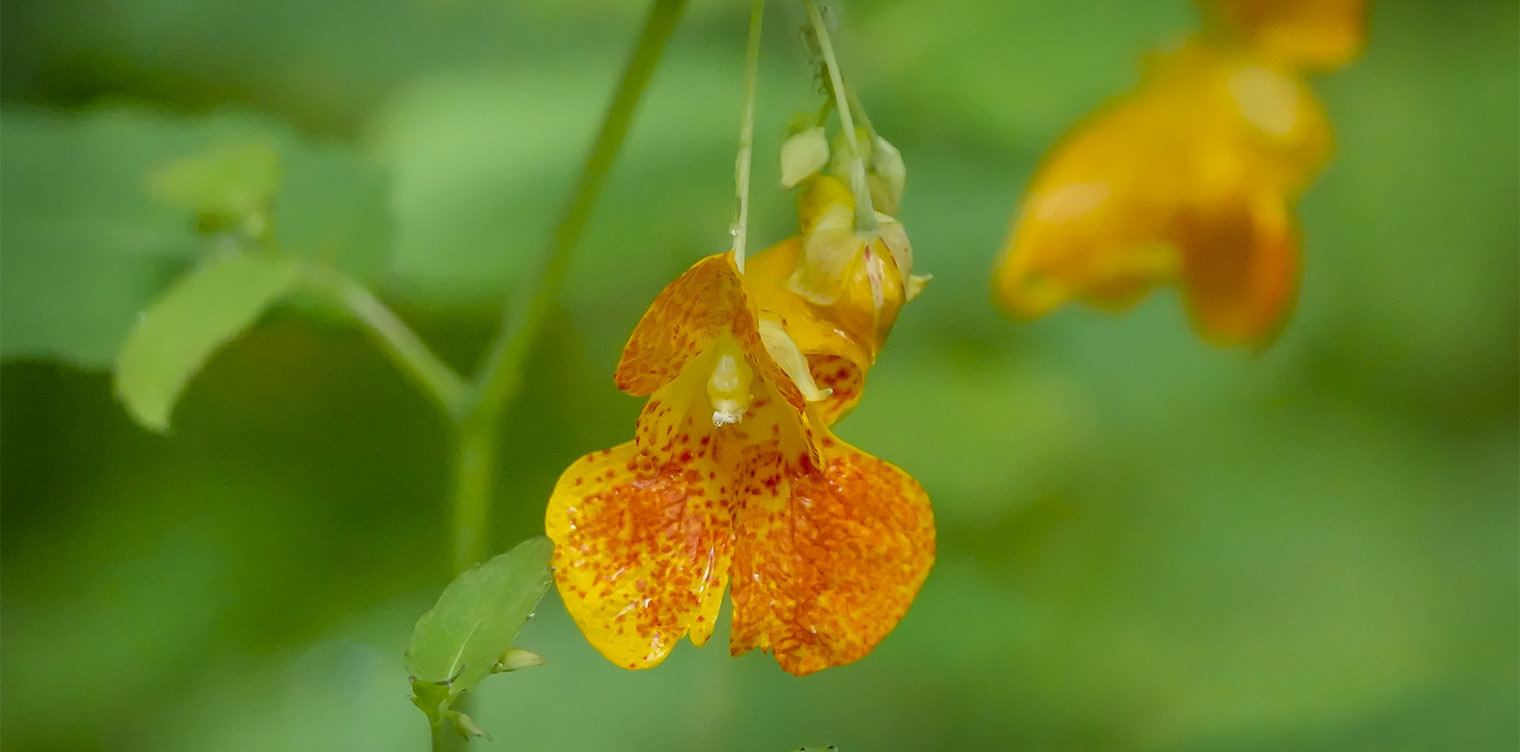
Spotted Touch-Me-Not (Impatiens capensis) is a summer-blooming Adirondack wildflower bearing one-inch orange flowers with red or dark orange spots. It is a member of the Balsaminaceae family.
- The genus name (Impatiens) is Latin for "impatience." This is a reference to the seed, which explodes on touch when ripe.
- The species name (capensis) is a reference to the Cape of Good Hope. It was initially thought that the plant originated in that area.
- The author name (Meerb.) refers to Nicolaas Meerburgh, a Dutch botanist of the 18th and early 19th century who directed the botanical garden in Leiden.
- Older sources may refer to the Spotted Touch-me-not as Impatiens biflora.
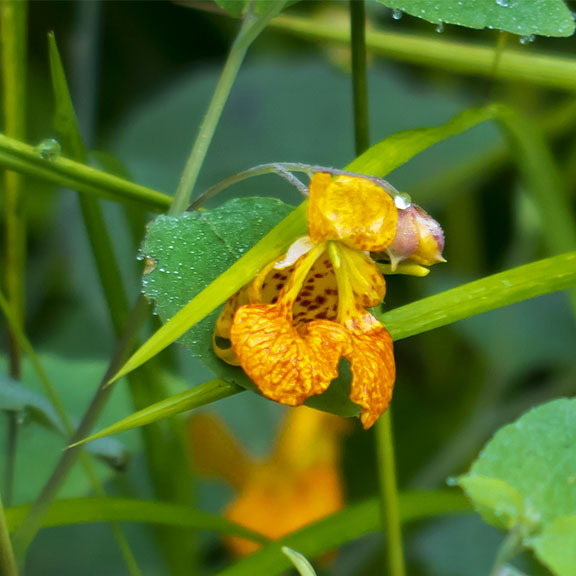
The common name (Spotted Touch-me-not) is a reference to the seed pods popping open at a touch, a characteristic which also explains two other common names – Snapweed and Spotted Snap Weed.
The plant is also known as Jewelweed and Spotted Jewelweed. There are several competing explanations for these names.
- Some sources attribute it to the fact that the orange flowers tend to glisten in the sunlight.
- Others trace the name to the fact that the blossoms hang like pendants from the branches.
- Still others contend that the name comes from the fact that "jewels" of water collect on the edges of the leaves.
Other common names for Impatiens capensis include Silver Leaf and Silver-cap Lady's Eardrops, apparently in reference to the silvery sheen on the leaves.
Spotted Touch-me-not is one of three impatiens species in the Adirondack Park. The others are Himalayan Balsam (Impatiens glandulifera) and Pale Touch-me-not (Impatiens pallida).
Identification of Spotted Touch-Me-Not
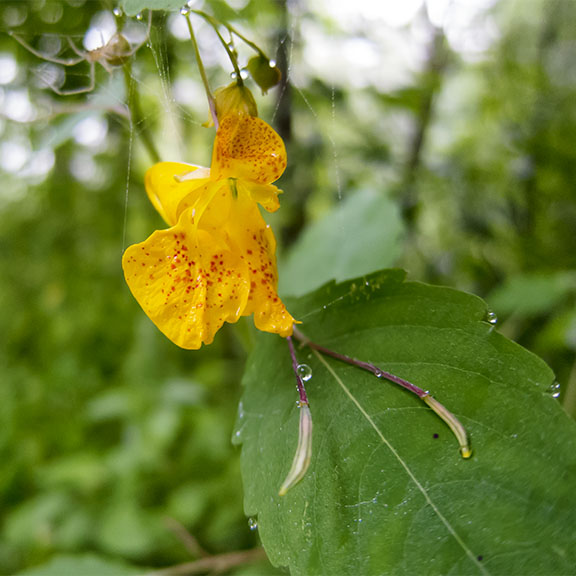
In contrast to most of our native wildflowers, Spotted Touch-me-not is an annual, reproducing from seed each spring. Seedlings sprout in early spring, reaching maximum size in late summer.
Spotted Touch-me-not is a tall, erect plant, growing two to five feet tall. Its pale green stems are hairless and succulent, exuding juice when broken.
The oval leaves are 1 to 3 inches long and up to 1½ inches wide. They are arranged alternately, meaning that they emerge from the stem one leaf per node. Like the stems, they are hairless and somewhat succulent. The leaf has a distinct leaf stalk. The leaf edges have low, widely-spaced teeth.
The leaves are covered with a coating that repels water. Water drops usually roll off the leaves, but in horizontal areas, the water beads up, appearing like jewels in the reflected light. When submerged in water, the leaves take on a silvery sheen. The function of this waterproofing is unknown.
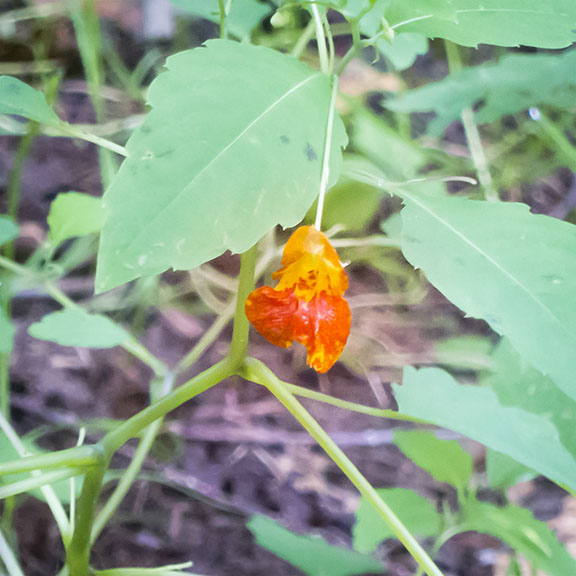
Spotted Touch-me-not has two different types of flowers: small, inconspicuous flowers that don't open and the larger, showy flowers from which the plant draws many of its common names. These latter flowers are about an inch long.
- Spotted Touch-me-not flowers have dark reddish-brown spots on a yellowish-orange base.
- The flowers dangle on stalks on the upper part of the stems.
- The flower is shaped like a cornucopia, with a prominent spur at the base about ¼ inch long. The spur is usually curled and bends forward until parallel with the flower.
The color and shape of the flower is one of the keys to distinguishing Spotted Touch-me-not from Pale Touch-me-not (I. pallida), which occurs in similar habitats in the Adirondack region.
- Pale Touch-me-not, also known as Yellow Jewelweed, has large lemon-yellow flowers with fewer and smaller reddish spots.
- Pale Touch-me-not's spur, in contrast to that of Spotted Touch-me-not, is usually bent at a right angle to the flower.
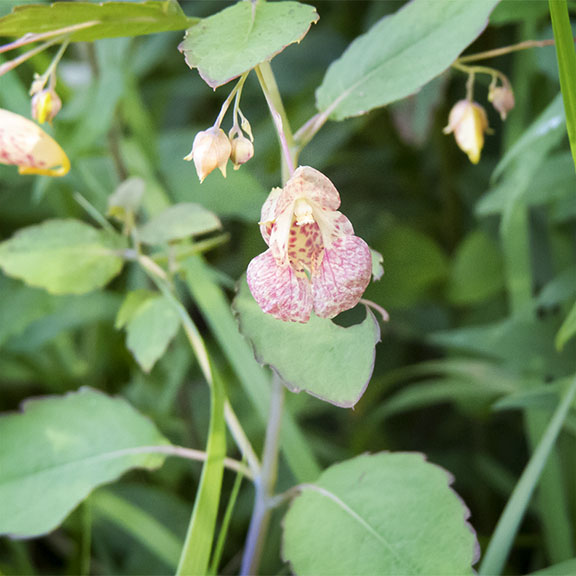
In the Adirondack Park, Spotted Touch-me-not is usually in flower from July through early September. Each flower only lasts for a day or so, but the flowering season is quite lengthy; and you can often find flower buds, flowers, and fruits at the same time.
The fruit of Spotted Touch-me-not consists of pale green pods. The narrow capsule is about an inch long and divided into five sections. These spring apart when touched, throwing seeds in all directions. The seeds are brown and usually number 3 to 5 per pod. The seeds are dormant through the winter, germinating in April and May.
Uses of Spotted Touch-Me-Not
There is contradictory reporting on the plant's edibility. Some reports indicate that the succulent stems can be cut up and cooked like green beans, while others warn that the plant (especially if eaten raw) should not be ingested in large quantities. Some sources suggest that the seeds taste like walnuts.
Spotted Touch-Me-Not's main use is medicinal.
- Spotted Touch-me-not was used as a medicinal herb by several native American groups. The Cherokee, for instance, used an infusion of the leaf for measles. The Chippewa applied a poultice of bruised stems to rashes and other skin troubles. The Iroquois used a cold infusion of plants for fevers.
- Most sources on modern herbal remedies indicate that Spotted Touch-me-not is an effective remedy for the the pain and itching of poison ivy or poison sumac. The stem and foliage is said to contain compounds that neutralize uroshiol, which causes contact dermatitis.
Wildlife Value of Spotted Touch-Me-Not
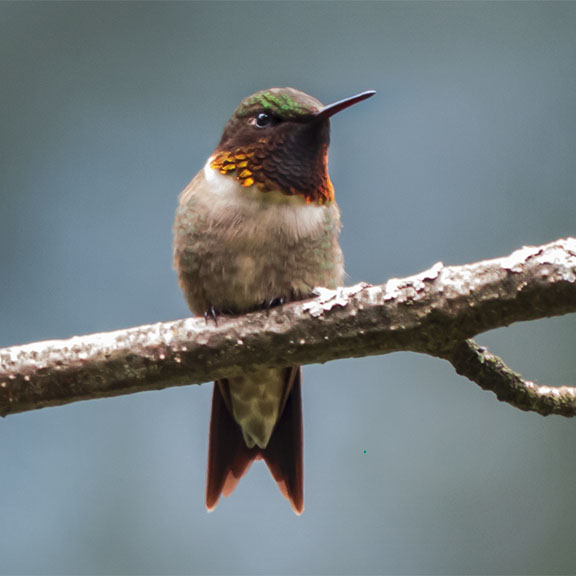
Spotted Touch-me-not is an important nectar source for the Ruby-throated Hummingbird, which contributes to its pollination. The Spotted Touch-me-not is considered to be a hummingbird flower. Hummingbirds can use their long slender beaks to penetrate the base of the plant's long tubular flowers. Nectar from touch-me-nots is said to comprise 5 to 10% of the Ruby-throated Hummingbird's diet.
Bees and butterflies are also attracted by the flowers. Grasshoppers, beetles, and katydids reportedly feed on the Spotted Touch-me-not's buds and flowers. Other insects feed on the foliage, including leaf beetles, (which may defoliate an entire plant) and the caterpillars of several moths.
Several bird species, including Ruffed Grouse and Ring-necked Pheasant, eat the seeds, although they are not a major food source, providing only ½ to 2% of their diet. A few mammal species, such as the White-footed Mouse and Short-tailed Shrews, also consume the seeds. The seeds of Spotted Touch-me-not is reported to comprise ½ to 2% of the White-tailed Mouse's diet. One report suggests that White-tailed Deer browse on the foliage, although it does not appear to constitute a major part of its diet.
Distribution of Spotted Touch-Me-Not
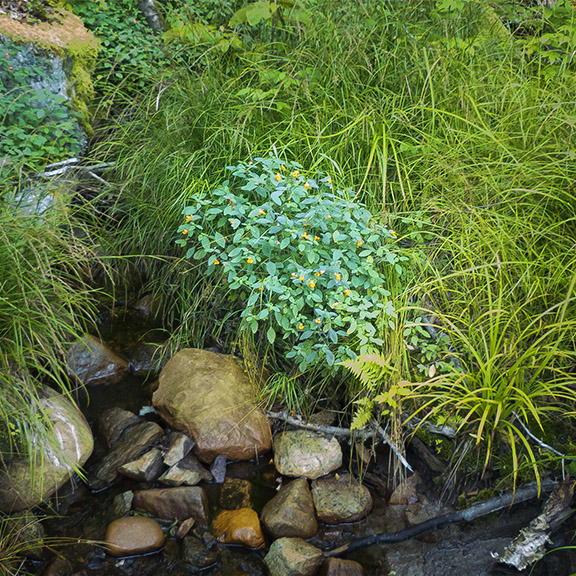
Spotted Touch-me-not is widely distributed across the North American continent. It occurs throughout the eastern two-thirds of the US, as well as Canada. It can be found from Newfoundland to Alaska, south to Florida and Texas, and west to Colorado, with disjunct populations in Oregon, Washington, and Idaho.
In New York State, Spotted Touch-me-not is found in most counties, especially in the eastern part of the state. It has been found in all of the counties within the Adirondack Park Blue Line, except Hamilton and Herkimer counties.
Habitat of Spotted Touch-Me-Not
Spotted Touch-Me-Not is shade-tolerant, but can grow in partial sun. It prefers poorly drained sites with a high water table, but also has been found in non-wetlands. It flourishes in swamps, marshes, stream banks, thickets, and ditches throughout New York State.
In the Adirondacks, Spotted Touch-me-not is very common and found in several ecological communities:
Look for Spotted Touch-me-not growing in swampy areas in mixed woods forests, growing near Northern White Cedar, Red Maple, Eastern Hemlock, Yellow Birch, and Balsam Fir. Ground-layer herbs growing nearby include Goldthread, Partridgeberry, Bunchberry, Canada Mayflower, and Clintonia. Ferns that can be found in this ecological community include Sensitive Fern, Cinnamon Fern, and Royal Fern. Characteristic birds include Winter Wrens, White-throated Sparrows, and Golden-crowned Kinglets.
Spotted Touch-me-not is found on many of the trails covered here, including swampy areas along the Peninsula Nature Trails, Henry's Woods Loop Trail, Hulls Falls Road, Jackrabbit Trail, and Bloomingdale Bog Trail. At the Paul Smith's College VIC, Spotted Touch-me-not can be found on the Jenkins Mountain Trail, Black Pond Trail, Fox Run Trail, Heron Marsh Trail, and Barnum Brook Trail.
References
Michael Kudish. Adirondack Upland Flora: An Ecological Perspective (The Chauncy Press, 1992), p. 176.
Michael Kudish. Paul Smiths Flora II: Additional Vascular Plants; Bryophytes (Mosses and Liverworts); Soils and Vegetation; Local Forest History (Paul Smith's College, 1981), pp. 44-47.
New York Flora Association. New York Flora Atlas. Spotted Jewelweed. Impatiens capensis Meerb. Retrieved 22 November 2017.
Integrated Taxonomic Information System. Impatiens capensis Meerb. Retrieved 22 November 2017.
United States Department of Agriculture. The Plants Database. Jewelweed. Impatiens capensis Meerb. Retrieved 22 November 2017.
United States Department of Agriculture. Forest Service. Plant of the Week. Jewelweed. Impatiens capensis. Retrieved 22 November 2017.
NatureServe Explorer. Online Encyclopedia of Life. Orange Jewelweed. Impatiens capensis – Meerb. Retrieved 22 November 2017.
New England Wildflower Society. Go Botany. Jewelweed. Impatiens capensis Meerb. Retrieved 22 November 2017.
New York State. Department of Environmental Conservation. New York Natural Heritage Program. Ecological Communities of New York State. Second Edition (March 2014), pp. 48-49, 66, 69-70. Retrieved 17 October 2015.
New York Natural Heritage Program. 2021. Online Conservation Guide for Floodplain Forest. Retrieved 11 August 2021.
New York Natural Heritage Program. 2021. Online Conservation Guide for Shallow Emergent Marsh. Retrieved 11 August 2021.
New York Natural Heritage Program. 2021. Online Conservation Guide for Silver Maple-Ash Swamp. Retrieved 11 August 2021.
New York Natural Heritage Program. 2021. Online Conservation Guide for Northern White Cedar Swamp. Retrieved 11 August 2021.
New York Natural Heritage Program. 2021. Online Conservation Guide for Sedge Meadow. Retrieved 11 August 2021.
New York Natural Heritage Program. 2021. Online Conservation Guide for Hemlock-Hardwood Swamp. Retrieved 11 August 2021..
New York State. Adirondack Park Agency. Preliminary List of Species Native Within the Adirondack Park Listed Alphabetically by Scientific Name and Sorted by Habit. Volume 1. Updated 10.23.2006, p. 25. Retrieved 26 January 2017.
USA National Phenology Network. Nature’s Notebook. Impatiens capensis. Retrieved 22 November 2017.
Connecticut Botanical Society. Jewelweed. Impatiens capensis Meerb.
Retrieved 22 November 2017.
University of Wisconsin. Flora of Wisconsin. Impatiens capensis Meerb. Retrieved 22 November 2017.
Minnesota Wildflowers. Spotted Touch-me-not. Impatiens capensis. Retrieved 22 November 2017.
Illinois Wildflowers. Orange Jewelweed. Impatiens capensis. Retrieved 22 November 2017.
Eloise Butler Wildflower Garden. The Friends of the Wild Flower Garden. Spotted Touch-me-not. Retrieved 22 November 2017.
Lady Bird Johnson Wildflower Center. Impatiens capensis Meerb. Retrieved 22 November 2017.
Online Encyclopedia of Life. Wild Touch-me-not. Impatiens capensis. Retrieved 22 November 2017.
iNaturalist. Common Jewelweed. Impatiens capensis. Retrieved 11 August 2021.
iNaturalist. Adirondack Park Observations. Common Jewelweed. Impatiens capensis. Retrieved 11 August 2021.
Anne McGrath. Wildflowers of the Adirondacks (EarthWords, 2000), p. 87, Plate 26.
Roger Tory Peterson and Margaret McKenny. A Field Guide to Wildflowers. Northeastern and North-central North America (Houghton Mifflin Company, 1968), pp. 104, 208-209.
Doug Ladd. North Woods Wildflowers (Falcon Publishing, 2001), p. 118.
Lawrence Newcomb. Newcomb's Wildflower Guide (Little Brown and Company, 1977), pp. 54-55.
Meiyin Wu & Dennis Kalma. Wetland Plants of the Adirondacks: Herbaceous Plants and Aquatic Plants (Trafford Publishing, 2011), p. 70.
Donald D. Cox. A Naturalist's Guide to Wetland Plants. An Ecology for Eastern North America (Syracuse University Press, 2002), pp. 54-55, 114, 130.
David M. Brandenburg. Field Guide to Wildflowers of North America (Sterling Publishing Company, Inc., 2010), p. 153.
John Kricher. A Field Guide to Eastern Forests. North America (Houghton Mifflin, 1998), pp. 328-329.
Timothy Coffey. The History and Folklore of North American Wildflowers (FactsOnFile, 1993), pp. 150-151.
Ruth Schottman. Trailside Notes. A Naturalist's Companion to Adirondack Plants (Adirondack Mountain Club, 1998), pp. 102-106.
Wilbur H. Duncan and Marion B. Duncan. Wildflowers of the Eastern United States (The University of Georgia Press, 1999), p. 48, Plate 177.
National Audubon Society. Field Guide to North American Wildflowers. Eastern Region (Alfred A. Knopf, 2001), pp. 424-425, Plate 365.
William K. Chapman et al., Wildflowers of New York in Color (Syracuse University Press, 1998), pp. 100-101.
Mark J. Twery, at al. Changes in Abundance of Vascular Plants under Varying Silvicultural Systems at the Forest Ecosystem Research and Demonstration Area, Paul Smiths, New York. USDA Forest Service. Research Note NRS-169. Retrieved 22 January 2017, p. 7.
Alexander C. Martin, Herbert S. Zim, and Arnold L. Nelson. American Wildlife & Plants. A Guide to Wildlife Food Habits (Dover Publications, 1951), pp. 411-412.
John Eastman. The Book of Swamp and Bog: Trees, Shrubs, and Wildflowers of Eastern Freshwater Wetlands (Stackpole Books, 1995), pp. 91-95.
Plants for a Future. Impatiens capensis - Meerb. Retrieved 22 November 2017.
Steven Foster and James A. Duke. Medicinal Plants and Herbs of Eastern and Central North America (Houghton Mifflin Harcourt, 2014), pp. 154-155.
Bradford Angier. Field Guide to Medicinal Wild Plants. Revised and Updated. Second Edition. (Stackpole Books, 2008), pp. 92-93.
Katie Letcher Lyle. The Complete Guide to Edible Wild Plants, Mushrooms, Fruits, and Nuts. Finding, Identifying, and Cooking (Falcon Guides, 2017), pp. 45-47.
University of Michigan. Native American Ethnobotany. A Database of Foods, Drugs, Dyes and Fibers of Native American Peoples, Derived from Plants. Jewelweed. Impatiens capensis Meerb. Retrieved 22 November 2017.
The Cornell Lab of Ornithology. Birds of North America. Subscription web site. Ruby-throated Hummingbird. Retrieved 22 November 2017.
Iowa State University. BugGuide. Panorpa claripennis. Retrieved 22 November 2017.
Allen J. Coombes. Dictionary of Plant Names (Timber Press, 1994), pp. 94-95.
Charles H. Peck. Plants of North Elba (Bulletin of the New York State Museum, Volume 6, Number 28, June 1899). p. 83. Retrieved 22 February 2017.
Peter F. Zika, “Lectotypification of the Names of Two Color Forms of Impatiens Capensis (Balsaminaceae),” Rhodora, Volume 108, No. 933 (Winter 2006), pp. 62-64. Retrieved 26 November 2017.
Knowlton Foote, “Orange Jewelweed (Impatiens capensis Meerburgh),’ in New York Flora Association Newsletter, Volume 18, No. 2 (Summer 2007), pp. 10-16. Retrieved 26 November 2017.
C. A. Weatherby, “Color Forms of Impatiens Biflora,” Rhodora, Volume 19, No. 223 (July 1917), pp. 115-118. Retrieved 26 November 2017.
B. A. Weatherby, “Further Notes on Impatiens Biflora,” Rhodora, Vol. 21, No. 245 (May 1919), pp. 98-100. Retrieved 26 November 2017.
Wildflowers of the Adirondack Park
